JavaScript的Prototype
对象基础
我们知道Javascript中的变量定义基本如下:
var name = 'Chen Hao'; var email = 'haoel(@)hotmail.com'; var website = 'http://coolshell.cn';
如果要用对象来写的话,就是下面这个样子:
var chenhao = {
name :'Chen Hao',
email : 'haoel(@)hotmail.com',
website : 'http://coolshell.cn'
};
于是,我就可以这样访问:
//以成员的方式 chenhao.name; chenhao.email; chenhao.website; //以hash map的方式 chenhao["name"]; chenhao["email"]; chenhao["website"];
关于函数,我们知道Javascript的函数是这样的:
var doSomething = function(){
alert('Hello World.');
};
于是,我们可以这么干:
var sayHello = function(){
var hello = "Hello, I'm "+ this.name
+ ", my email is: " + this.email
+ ", my website is: " + this.website;
alert(hello);
};
chenhao.Hello = sayHello; //直接赋值,这里很像C/C++的函数指针
chenhao.Hello();
};
相信这些东西都比较简单,大家都明白了。 可以看到javascript对象函数是直接声明,
直接赋值,直接就用了。runtime的动态语言。
还有一种比如规范的写法是:
{{{class="brush: javascript"
//我们可以看到, 其用function来做class。
var Person = function(name, email, website){
this.name = name;
this.email = email;
this.website = website;
this.sayHello = function(){
var hello = "Hello, I'm "+ this.name + ", n" +
"my email is: " + this.email + ", n" +
"my website is: " + this.website;
alert(hello);
};
};
var chenhao = new Person("Chen Hao", "haoel@hotmail.com",
"http://coolshell.cn");
chenhao.sayHello();
顺便说一下,要删除对象的属性,很简单:
delete chenhao['email']
上面的这些例子,我们可以看到这样几点:
- Javascript的数据和成员封装很简单。
-
Javascript的function中的
this指针很关键,如果没有的话,那就是局部变量或局部 函数。 - Javascript对象成员函数可以在使用时临时声明,并把一个全局函数直接赋过去就好了。
- Javascript的成员函数可以在实例上进行修改,也就是说不同的实例的同一个函数名的 行为和实现不一样。
属性配置– Object.defineProperty
先看下面的代码:
//创建对象
var chenhao = Object.create(null);
//设置一个属性
Object.defineProperty( chenhao, 'name', {
value: 'Chen Hao',
writable: true,
configurable: true,
enumerable: true
});
//设置多个属性
Object.defineProperties( chenhao, {
'email': {
value: 'haoel@hotmail.com',
writable: true,
configurable: true,
enumerable: true
},
'website': { value: 'http://coolshell.cn',
writable: true,
configurable: true,
enumerable: true
}
});
下面就说说这些属性配置是什么意思:
- writable:这个属性的值是否可以改。
- configurable:这个属性的配置是否可以改。
-
enumerable:这个属性是否能在for…in循环中遍历出来或在
Object.keys中列举出来。 - value:属性值。
-
get()/set(_value):get和set访问器。
Get/Set 选择器
关于get/set访问器,它的意思就是用get/set来取代value(其不能和value一起使用), 示例如下:
var age = 0;
Object.defineProperty( chenhao, 'age', {
get: function() {return age+1;},
set: function(value) {age = value;}
enumerable : true,
configurable : true
}
);
chenhao.age = 100; //调用set
alert(chenhao.age); //调用get 输出101;
我们再看一个更为实用的例子——利用已有的属性age通过get和set构造新的属性
birth_year:
Object.defineProperty( chenhao, 'birth_year', {
get: function() {
var d = new Date();
var y = d.getFullYear();
return ( y - this.age );
},
set: function(year) {
var d = new Date();
var y = d.getFullYear();
this.age = y - year;
}
});
alert(chenhao.birth_year);
chenhao.birth_year = 2000;
alert(chenhao.age);
这样做好像有点麻烦,你说,我为什么不写成下面这个样子:
var chenhao = {
name: "Chen Hao",
email: "haoel@hotmail.com",
website: "http://coolshell.cn",
age: 100,
get birth_year() {
var d = new Date();
var y = d.getFullYear();
return ( y - this.age );
},
set birth_year(year) {
var d = new Date();
var y = d.getFullYear();
this.age = y - year;
}
};
alert(chenhao.birth_year);
chenhao.birth_year = 2000;
alert(chenhao.age);
是的,你的确可以这样的,不过通过defineProperty()你可以干这些事:
- 设置如 writable,configurable,enumerable 等这类的属性配置。
- 动态地为一个对象加属性。比如:一些HTML的DOM对像。
查看对象属性配置
如果查看并管理对象的这些配置,下面有个程序可以输入这些东西:
//列出对象的属性.
function listProperties(obj)
{
var newLine = "";
var names = Object.getOwnPropertyNames(obj);
for (var i = 0; i < names.length; i++) {
var prop = names[i];
document.write(prop + newLine);
// 列出对象的属性配置(descriptor)动用getOwnPropertyDescriptor函数。
var descriptor = Object.getOwnPropertyDescriptor(obj, prop);
for (var attr in descriptor) {
document.write("..." + attr + ': ' + descriptor[attr]);
document.write(newLine);
}
document.write(newLine);
}
}
listProperties(chenhao);
call(),apply(),bind()和this
关于Javascript的this指针,和C++/Java很类似。 我们来看个示例:(这个示例很简单了 ,我就不多说了)
function print(text){
document.write(this.value + ' - ' + text+ '');
}
var a = {value: 10, print : print};
var b = {value: 20, print : print};
print('hello');// this => global, output "undefined - hello"
a.print('a');// this => a, output "10 - a"
b.print('b'); // this => b, output "20 - b"
a['print']('a'); // this => a, output "10 - a"
我们再来看看call和apply,这两个函数的差别就是参数的样子不一样,另一个就是性能 不一样,apply的性能要差很多。(关于性能,可到JSPerf上去跑跑看看)
print.call(a, 'a'); // this => a, output "10 - a" print.call(b, 'b'); // this => b, output "20 - b" print.apply(a, ['a']); // this => a, output "10 - a" print.apply(b, ['b']); // this => b, output "20 - b"
但是在bind后,this指针,可能会有不一样,但是因为Javascript是动态的。如下面的示例
var p = print.bind(a);
p('a'); // this => a, output "10 - a"
p.call(b, 'b'); // this => a, output "10 - b"
p.apply(b, ['b']); // this => a, output "10 - b"
继承和重载
通过上面的那些示例,我们可以通过Object.create()来实际继承,请看下面的代码,
Student继承于Object:
var Person = Object.create(null);
Object.defineProperties
(
Person,
{
'name' : { value: 'Chen Hao'},
'email' : { value : 'haoel@hotmail.com'},
'website': { value: 'http://coolshell.cn'}
}
);
Person.sayHello = function (person) {
var hello = "<p>Hello, I am "+ this.name + ", " +
"my email is: " + this.email + ", " +
"my website is: " + this.website;
document.write(hello + "");
}
var Student = Object.create(Person);
Student.no = "1234567"; //学号
Student.dept = "Computer Science"; //系
//检查Person的属性
document.write(Student.name + ' ' + Student.email + ' ' + Student.website +'');
//检查Person的方法
Student.sayHello();
//重载SayHello方法
Student.sayHello = function (person) {
var hello = "<p>Hello, I am "+ this.name + ", " +
"my email is: " + this.email + ", " +
"my website is: " + this.website + ", " +
"my student no is: " + this. no + ", " +
"my departent is: " + this. dept;
document.write(hello + '');
}
//再次调用
Student.sayHello();
//查看Student的属性(只有 no 、 dept 和 重载了的sayHello)
document.write('<p>' + Object.keys(Student) + '');
通用上面这个示例,我们可以看到,Person里的属性并没有被真正复制到了Student中来, 但是我们可以去存取。这是因为Javascript用委托实现了这一机制。其实,这就是 Prototype,Person是Student的Prototype。
当我们的代码需要一个属性的时候,Javascript的引擎会先看当前的这个对象中是否有这个 属性,如果没有的话,就会查找他的Prototype对象是否有这个属性,一直继续下去,直到 找到或是直到没有Prototype对象。
为了证明这个事,我们可以使用Object.getPrototypeOf()来检验一下:
Student.name = 'aaa';
document.write('<p>' + Student.name + '</p>'); //输出 aaa
document.write('<p>' +Object.getPrototypeOf(Student).name + '</p>');
//输出 Chen Hao
于是,你还可以在子对象的函数里调用父对象的函数,就好像C++里的Base::func()一样
。于是,我们重载hello()的方法就可以使用父类的代码了:
//新版的重载SayHello方法
Student.sayHello = function (person) {
Object.getPrototypeOf(this).sayHello.call(this);
var hello = "my student no is: " + this. no + ", " +
"my departent is: " + this. dept;
document.write(hello + '');
}
这个很强大吧。
组合
上面的那个东西还不能满足我们的要求,我们可能希望这些对象能真正的组合起来。为什么 要组合?因为我们都知道是这是OO设计的最重要的东西。不过,这对于Javascript来并没有 支持得特别好,不好我们依然可以搞定个事。
首先,我们需要定义一个Composition的函数:(target是作用于是对象,source是源对象 ),下面这个代码还是很简单的,就是把source里的属性一个一个拿出来然后定义到target 中。
function Composition(target, source)
{
var desc = Object.getOwnPropertyDescriptor;
var prop = Object.getOwnPropertyNames;
var def_prop = Object.defineProperty;
prop(source).forEach(
function(key) {
def_prop(target, key, desc(source, key))
}
)
return target;
}
有了这个函数以后,我们就可以这来玩了:
//艺术家
var Artist = Object.create(null);
Artist.sing = function() {
return this.name + ' starts singing...';
}
Artist.paint = function() {
return this.name + ' starts painting...';
}
//运动员
var Sporter = Object.create(null);
Sporter.run = function() {
return this.name + ' starts running...';
}
Sporter.swim = function() {
return this.name + ' starts swimming...';
}
Composition(Person, Artist);
document.write(Person.sing() + '');
document.write(Person.paint() + '');
Composition(Person, Sporter);
document.write(Person.run() + '');
document.write(Person.swim() + '');
看看 Person中有什么?
document.write('<p>' + Object.keys(Person) + '');
// 输出:sayHello,sing,paint,swim,run
Prototype 和 继承
我们先来说说Prototype。我们先看下面的例程,这个例程不需要解释吧,很像C语言里的 函数指针,在C语言里这样的东西见得多了。
var plus = function(x,y){
document.write( x + ' + ' + y + ' = ' + (x+y) + '');
return x + y;
};
var minus = function(x,y){
document.write(x + ' - ' + y + ' = ' + (x-y) + '');
return x - y;
};
var operations = {
'+': plus,
'-': minus
};
var calculate = function(x, y, operation){
return operations[operation](x, y);
};
calculate(12, 4, '+');
calculate(24, 3, '-');
那么,我们能不能把这些东西封装起来呢,我们需要使用prototype。看下面的示例:
var Cal = function(x, y){
this.x = x;
this.y = y;
}
Cal.prototype.operations = {
'+': function(x, y) { return x+y;},
'-': function(x, y) { return x-y;}
};
Cal.prototype.calculate = function(operation){
return this.operations[operation](this.x, this.y);
};
var c = new Cal(4, 5);
Cal.calculate('+');
Cal.calculate('-');
这就是prototype的用法,prototype 是javascript这个语言中最重要的内容。网上有太多 的文章介始这个东西了。说白了,prototype就是对一对象进行扩展,其特点在于通过 「复制」一个已经存在的实例来返回新的实例,而不是新建实例。
被复制的实例就是我们所称的「原型」,这个原型是可定制的(当然,这里没有真正的复制, 实际只是委托)。上面的这个例子中,我们扩展了实例Cal,让其有了一个operations的 属性和一个calculate的方法。
这样,我们可以通过这一特性来实现继承。还记得我们最最前面的那个Person吧,下面的 示例是创建一个Student来继承Person。
function Person(name, email, website){
this.name = name;
this.email = email;
this.website = website;
};
Person.prototype.sayHello = function(){
var hello = "Hello, I am "+ this.name + ", " +
"my email is: " + this.email + ", " +
"my website is: " + this.website;
return hello;
};
function Student(name, email, website, no, dept){
var proto = Object.getPrototypeOf;
proto(Student.prototype).constructor.call(this, name, email, website);
this.no = no;
this.dept = dept;
}
// 继承prototype
Student.prototype = Object.create(Person.prototype);
//重置构造函数
Student.prototype.constructor = Student;
//重载sayHello()
Student.prototype.sayHello = function(){
var proto = Object.getPrototypeOf;
var hello = proto(Student.prototype).sayHello.call(this) + '';
hello += "my student no is: " + this. no + ", " +
"my departent is: " + this. dept;
return hello;
};
var me = new Student(
"Chen Hao",
"haoel@hotmail.com",
"http://coolshell.cn",
"12345678",
"Computer Science"
);
document.write(me.sayHello());
兼容性
上面的这些代码并不一定能在所有的浏览器下都能运行,因为上面这些代码遵循 ECMAScript 5的规范,关于ECMAScript 5 的浏览器兼容列表,你可以看这里: ES5浏览器兼容表
本文中的所有代码都在Chrome最新版中测试过了。
下面是一些函数,可以用在不兼容ES5的浏览器中:
Object.create()函数
function clone(proto) {
function Dummy() { }
Dummy.prototype = proto;
Dummy.prototype.constructor = Dummy;
return new Dummy(); //等价于Object.create(Person);
}
var me = clone(Person);
defineProperty()函数
function defineProperty(target, key, descriptor) {
if (descriptor.value){
target[key] = descriptor.value;
}else {
descriptor.get && target.__defineGetter__(key, descriptor.get);
descriptor.set && target.__defineSetter__(key, descriptor.set);
}
return target
}
keys()函数
function keys(object) { var result, key
result = [];
for (key in object){
if (object.hasOwnProperty(key)) result.push(key)
}
return result;
}
Object.getPrototypeOf() 函数
function proto(object) {
return !object? null
: '__proto__' in object? object.__proto__
: /* not exposed? */ object.constructor.prototype
}
bind 函数
var slice = [].slice
function bind(fn, bound_this) { var bound_args
bound_args = slice.call(arguments, 2)
return function() { var args
args = bound_args.concat(slice.call(arguments))
return fn.apply(bound_this, args) }
}
原型
函数创建过程
在了解原型链之前我们先来看看一个函数在创建过程中做了哪些事情,举一个空函数的例子 :
function A() {};
当我们在代码里面声明这么一个空函数,js解析的本质是(肤浅理解有待深入):
-
创建一个对象(有constructor属性及
[[Prototype]]属性),根据ECMA,其中[[Prototype]]属性不可见、不可枚举 -
创建一个函数(有
name、prototype属性),再通过prototype属性引用刚才创建的 对象 -
创建变量
A,同时把函数的引用赋值给变量A。
如下图所示:

JavaScript原型和继承(注意图中都是「 引用 」类型)
每个函数的创建都经历上述过程。
构造函数
那么什么是构造函数呢?
按照ECMA的定义:Constructor is a function that creates and initializes the newly created object.
构造函数是用来新建同时初始化一个新对象的函数。
什么样的函数可以用来创建同时初始化新对象呢?答案是:任何一个函数,包括空函数。
所以,结论是:任何一个函数都可以是构造函数。
原型
根据前面空函数的创建图示,我们知道每个函数在创建的时候都自动添加了prototype
属性,这就是函数的原型,从图中可知其实质就是对一个对象的引用(这个对象暂且取名
原型对象)。
我们可以对函数的原型对象进行操作,和普通的对象无异!一起来证实一下。
围绕刚才创建的空函数,这次给空函数增加一些代码:
function A() {
this.width = 10;
this.data = [1,2,3];
this.key = "this is A";
}
A._objectNum = 0;//定义A的属性
A.prototype.say = function() { //给A的原型对象添加属性
alert("hello world")
}
其中给函数的原型对象增加一个say属性并引用一个匿名函数,根据「函数创建
」过程,图解如下:

(灰色背景就是在空函数基础上增加的属性)
简单说原型就是函数的一个属性,在函数的创建过程中由js编译器自动添加。
那么原型有什么用呢?
先了解下new运算符,如下:
var a1 = new A; var a2 = new A;
这是通过构造函数来创建对象的方式,那么创建对象为什么要这样创建而不是直接
用var a1 = {};呢?这就涉及new的具体步骤了,这里的new操作可以分成三步(以a1的
创建为例):
-
新建一个对象并赋值给变量
a1:var a1 = {}; -
把这个对象的
[[Prototype]]属性指向函数A的原型对象:a1.[[Prototype]] = A.prototype -
调用函数
A,同时把this指向第一步中创建的对象a1,对对象进行初始化:A.apply(a1,arguments)
其结构图示如下:
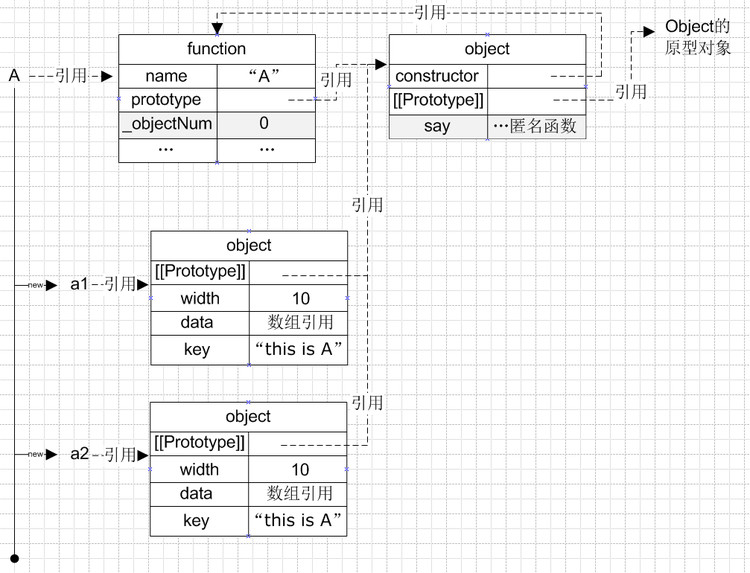
从图中看到,无论是对象a1还是a2,都有一个属性保存了对函数A的原型对象的引用
,对于这些对象来说,一些公用的方法可以在函数的原型中找到,节省了内存空间。
原型链
了解了new运算符以及原型的作用之后,一起来看看什么是[[Prototype]]?以及对象如何
沿着这个引用来进行属性的查找?
在js的世界里,每个对象默认都有一个[[Prototype]]属性,其保存着的地址就构成了
对象的原型链,它是由js编译器在对象 被创建 的时候自动添加的,其取值由new运算符的
右侧参数决定:
当我们var object1 = {};的时候,object1的[[Prototype]]就指向Object构造
函数的原型对象,因为var object1 = {};实质上等于var object = new Object();
(原因可参照上述对new A的分析过程)。
对象在查找某个属性的时候,会首先遍历自身的属性,如果没有则会继续查找
[[Prototype]]引用的对象,如果再没有则继续查找[[Prototype]].[[Prototype]]引用
的对象,依次类推,直到[[Prototype]].….[[Prototype]]为undefined(Object的
[[Prototype]]就是undefined)
//我们想要获取a1.fGetName alert(a1.fGetName);//输出undefined //1、遍历a1对象本身 //结果a1对象本身没有fGetName属性 //2、找到a1的[[Prototype]],也就是其对应的对象A.prototype,同时进行遍历 //结果A.prototype也没有这个属性 //3、找到A.prototype对象的[[Prototype]],指向其对应的对象Object.prototype //结果Object.prototype也没有fGetName //4、试图寻找Object.prototype的[[Prototype]]属性,结果返回undefined,这就是a1.fGetName的值
简单说就是通过对象的[[Prototype]]保存对另一个对象的引用,通过这个引用往上进行
属性的查找,这就是原型链。
继承
有了原型链的概念,就可以进行继承。
function B() {};
这个时候产生了B的原型B.prototype
原型本身就是一个Object对象,我们可以看看里面放着哪些数据
B.prototype实际上就是:
{
constructor : B,
[[Prototype]] : Object.prototype
}
因为prototype本身是一个Object对象的实例,所以其原型链指向的是Object的原型
B.prototype = A.prototype;
上面相当于把B的prototype指向了A的prototype;这样只是继承了A的prototype方法,A中 的自定义方法则不继承
B.prototype.thisisb = "this is constructor B";
上面的代码也会改变a的prototype
但是我们只想把B的原型链指向A,如何实现?
第一种是通过改变原型链引用地址
B.prototype.__proto__ = A.prototype;
ECMA中并没有__proto__这个方法,这个是ff、chrome等js解释器添加的,等同于EMCA的
[[Prototype]],这不是标准方法,那么如何运用标准方法呢?
我们知道new操作的时候,实际上只是把实例对象的原型链指向了构造函数的prototype
地址块,那么我们可以这样操作
B.prototype = new A();
这样产生的结果是:
产生一个A的实例,同时赋值给B的原型,也即B.prototype相当于对象:
{
width :10,
data : [1,2,3],
key : "this is A",
[[Prototype]] : A.prototype
}
这样就把A的原型通过B.prototype.[[Prototype]]这个对象属性保存起来,构成了原型的
链接
但是注意,这样B产生的对象的构造函数发生了改变,因为在B中没有constructor属性,
只能从原型链找到A.prototype,读出constructor:A:
var b = new B; console.log(b.constructor); //output A
所以我们还要人为设回B本身:
B.prototype.constructor = B;
现在B的原型就变成了:
{
width :10,
data : [1,2,3],
key : "this is A",
[[Prototype]] : A.prototype,
constructor : B
}
console.log(b.constructor); //output B
同时B直接通过原型继承了A的自定义属性width和name:
console.log(b.data);//output [1,2,3]
这样的坏处就是,直接改变了prototype的data数组(引用):
b.data.push(4); var c = new B; alert(c.data); //output [1,2,3,4]
其实我们想要的只是原型链,A的自定义属性我们想在B中进行定义(而不是在prototype) 。
该如何进行继承?既然我们不想要A中自定义的属性,那么可以想办法把其过滤。可以新建 一个空函数,把这个空函数的原型指向构造函数A的原型:
function F(){}
F.prototype = A.prototype;
这个时候再通过new操作把B.prototype的原型链指向F的原型:
B.prototype = new F;
这个时候B的原型变成了:
{ [[Prototype]] : F.prototype }
这里F.prototype其实只是一个地址的引用。但是由B创建的实例其constructor指向了
A,所以这里要显示设置一下B.prototype的constructor属性:
B.prototype.constructor = B;
这个时候B的原型变成了:
{
constructor : B ,
[[Prototype]] : F.prototype
}
这样就实现了B对A的原型继承。图示如下,其中红色部分代表原型链:
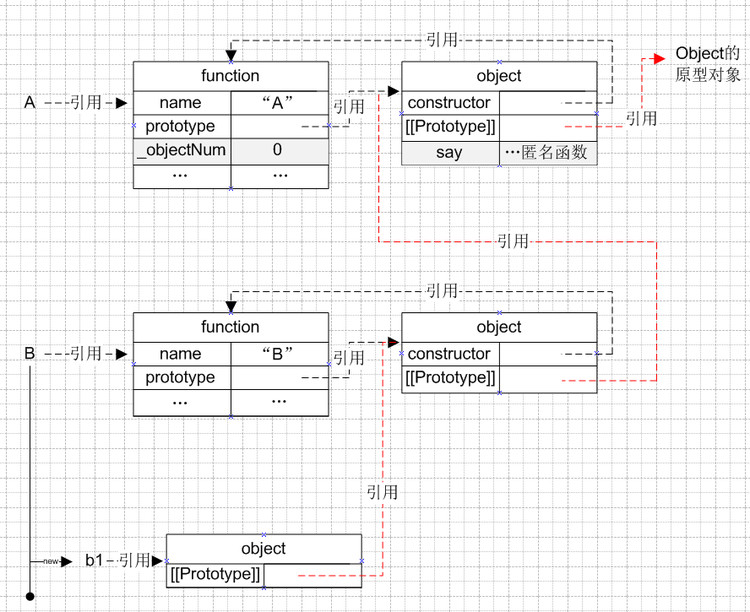
例子
首先我们先来回顾以下 javascript 中出现的原型继承:
function ParentScope() {
this.aString = "parent string";
this.aNumber = 100;
this.anArray = [10,20,30];
this.anObject = {
'property1': 'parent prop1',
'property2': 'parent prop2'
};
this.aFunction = function() {
return 'parent output';
}
}
function ChildScope() { }
ChildScope.prototype = new ParentScope();
var childScope = new ChildScope();
ChildScope 原型继承自 ParentScope
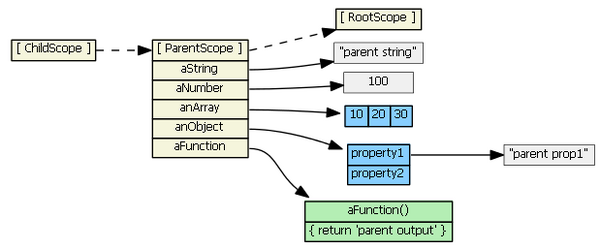
如果我们要在 childScope 上查询一个定义在 parentScope 的属性, JavaScript 会先在
childScope 上查找, 如果没有查到, 那么会顺着原型链去查找. 所以以下判别式均为
true:
childScope.aString === 'parent string' childScope.anArray[1] === 20 childScope.anObject.property1 === 'parent prop1' childScope.aFunction() === 'parent output'
如果我们做如下操作:
childScope.aString = 'child string'
原型链并没有被访问, 一个新的aString会被加入到 childScope 的属性中去,
新的属性会隐藏 parentScope 中的同名属性.
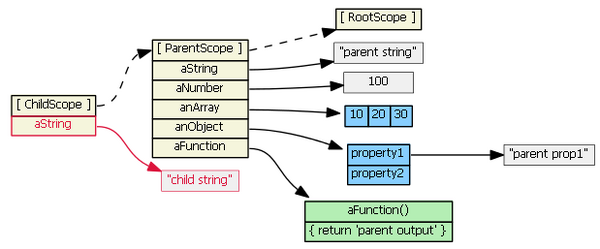
假设我们做出如下操作:
childScope.anArray[1] = 22 childScope.anObject.property1 = 'child prop1'
原型链被访问了. 因为 anArray, anObject 没有在 childScope 中找到. 新的赋值操作均在 parentScope 上进行. childScope 上没有添加任何新的属性.
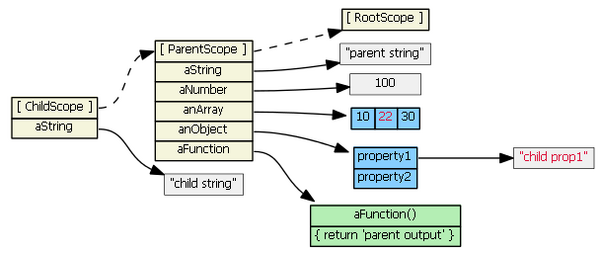
如果我们做出如下操作
childScope.anArray = [100, 555]
childScope.anObject = { name: 'Mark', country: 'USA' }
原型链没有被访问, childScope 会获得两个新的属性, 并且会隐藏 parentScope 上的同名属性.
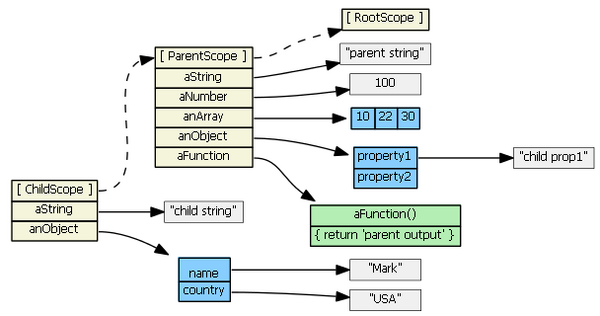
仔细体会上面的三次操作. 第一第三次均是对某个属性进行赋值, 原型链并不会被访问,
由于属性并不存在, 所以新的属性将会被添加. 而第二次其实是先访问,
childScope.anArray, childScope.anObject, 再对其访问的对象的某个属性进行复制.
总结:
- 如果我们读取 childScope.propertyX, 而 childScope 拥有 propertyX, 那么原型链不会被访问
- 如果我们读取 childScope.propertyX, 而 childScope 并没有 propertyX, 那么原型链会被访问.
- 如果对 childScope.propertyX 进行赋值, 那么原型链并不会被访问.
最后我们再来看一种情况:
delete childScope.anArray childScope.anArray[1] === 22 // true
我们显示删除了 childScope 的一个属性, 接着试图读取这个属性, 由于 childScope 并没有了这个属性, 所以原型链会被访问.
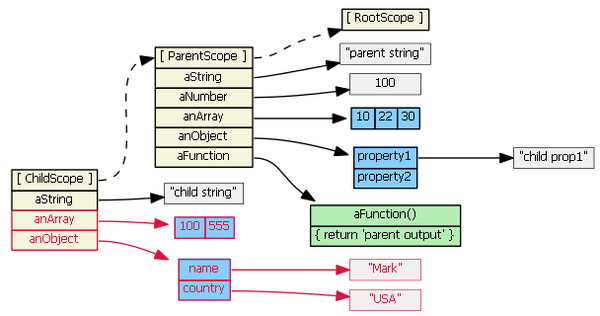
Function.prototype.bind()
函数绑定(Function binding)很有可能是你在开始使用JavaScript时最少关注的一点,
但是当你意识到你需要一个解决方案来解决如何在另一个函数中保持this上下文的时候,
你真正需要的其实就是Function.prototype.bind(),只是你有可能仍然没有意识到这点
。
第一次遇到这个问题的时候,你可能倾向于将this设置到一个变量上,这样你可以在改变了
上下文之后继续引用到它。很多人选择使用self,_this或者context作为变量名称(
也有人使用that)。这些方式都是有用的,当然也没有什么问题。但是其实有更好、
更专用的方式。
Jack Archibald 关于缓存 this 的微博(twitter):
Jake Archibald: 「我会为了作用域做任何事情,但是我不会使用 that = this」
我对这个问题更清晰的认识是在我看到Sindre Sorhus更清楚的描述之后:
Sindre Sorhus:「在jQuery中使用$this,但是对于纯JS我不会,我会使用.bind()」
而我在一开始的几个月里却忽略了这个明智的建议。
上下文变化改变this引用
在下面的例子代码中,我们可以名正言顺地将上下文缓存到一个变量中:
var myObj = {
specialFunction: function () { },
anotherSpecialFunction: function () { },
getAsyncData: function (cb) { cb(); },
render: function () {
var that = this;
this.getAsyncData(function () {
that.specialFunction();
that.anotherSpecialFunction();
});
}
};
myObj.render();
如果我们简单地使用this.specialFunction()来调用方法的话,会收到下面的错误:
Uncaught TypeError: Object [object global] has no method 'specialFunction'
通过bind绑定引用
我们需要为回调函数的执行保持对myObj对象上下文的引用。
调用that.specialFunction()让我们能够维持作用域上下文并且正确执行我们的函数。
然而使用Function.prototype.bind()可以有更加简洁干净的方式:
render: function () {
this.getAsyncData(function () {
this.specialFunction();
this.anotherSpecialFunction();
}.bind(this));
}
.bind()创建了一个函数,当这个函数在被调用的时候,它的this关键词会被设置成
被传入的值(这里指调用bind()时传入的参数)。因此,我们传入想要的上下文,
this(其实就是myObj),到.bind()函数中。然后,当回调函数被执行的时候,
this便指向myObj对象。
如果有兴趣想知道Function.prototype.bind()内部长什么样以及是如何工作的,
这里有个非常简单的例子:
Function.prototype.bind = function (scope) {
var fn = this;
return function () {
return fn.apply(scope);
};
}
还有一个非常简单的用例:
var foo = { x: 3 }
var bar = function(){ console.log(this.x); }
bar(); // undefined
var boundFunc = bar.bind(foo);
boundFunc(); // 3
我们创建了一个新的函数,当它被执行的时候,它的 this 会被设置成 foo —— 而不是 像我们调用 bar() 时的全局作用域。
浏览器支持与备用方案
| Browser | Version support |
|---|---|
| Chrome | 7 |
| Firefox (Gecko) | 4.0 (2) |
| Internet Explorer | 9 |
| Opera | 11.60 |
| Safari | 5.1.4 |
正如你看到的,很不幸,Function.prototype.bind 在IE8及以下的版本中不被支持,所以 如果你没有一个备用方案的话,可能在运行时会出现问题。
幸运的是,Mozilla Developer Network(很棒的资源库),为没有自身实现.bind()方法
的浏览器提供了一个绝对可靠的替代方案:
if (!Function.prototype.bind) {
Function.prototype.bind = function (oThis) {
if (typeof this !== "function") {
// closest thing possible to the ECMAScript 5 internal IsCallable function
throw new TypeError("Function.prototype.bind - what is trying to be bound is not callable");
}
var aArgs = Array.prototype.slice.call(arguments, 1),
fToBind = this,
fNOP = function () {},
fBound = function () {
return fToBind.apply(this instanceof fNOP && oThis
? this
: oThis,
aArgs.concat(Array.prototype.slice.call(arguments)));
};
fNOP.prototype = this.prototype;
fBound.prototype = new fNOP();
return fBound;
};
}
适用的模式
在学习技术点的时候,我发现有用的不仅仅在于彻底学习和理解概念,更在于看看在手头 的工作中有没有适用它的地方,或者比较接近它的的东西。我希望,下面的某些例子能够 适用于你的代码或者解决你正在面对的问题。
CLICK HANDLERS(点击处理函数)
一个用途是记录点击事件(或者在点击之后执行一个操作),这可能需要我们在一个对象中 存入一些信息,比如:
var logger = {
x: 0,
updateCount: function(){
this.x++;
console.log(this.x);
}
}
我们可能会以下面的方式来指定点击处理函数,随后调用logger对象中的
updateCount()方法。
document.querySelector('button').addEventListener('click', function(){
logger.updateCount();
});
但是我们必须要创建一个多余的匿名函数,来确保updateCount()函数中的this关键字
有正确的值。
我们可以使用如下更干净的方式:
document.querySelector('button').addEventListener('click',
logger.updateCount.bind(logger));
我们巧妙地使用了方便的.bind()函数来创建一个新的函数,而将它的作用域绑定为
logger对象。
SETTIMEOUT
如果你使用过模板引擎(比如Handlebars)或者尤其使用过某些MV*框架(从我的经验我 只能谈论Backbone.js),那么你也许知道下面讨论的关于在渲染模板之后立即访问新的 DOM节点时会遇到的问题。
假设我们想要实例化一个jQuery插件:
var myView = {
template: '/* 一个包含 <select /> 的模板字符串*/',
$el: $('#content'),
afterRender: function () {
this.$el.find('select').myPlugin();
},
render: function () {
this.$el.html(this.template());
this.afterRender();
}
}
myView.render();
你或许发现它能正常工作——但并不是每次都行,因为里面存在着问题。这是一个竞争的问题 :
只有先到达的才能获胜。有时候是渲染先到,而有时候是插件的实例化先到。【译者注:
如果渲染过程还没有完成(DOM Node还没有被添加到DOM树上),那么find('select')
将无法找到相应的节点来执行实例化。】
现在,或许并不被很多人知晓,我们可以使用基于setTimeout()的slight hack来解决
问题。
我们稍微改写一下我们的代码,就在DOM节点加载后再安全的实例化我们的jQuery插件:
//
afterRender: function () {
this.$el.find('select').myPlugin();
},
render: function () {
this.$el.html(this.template());
setTimeout(this.afterRender, 0);
}
//
然而,我们获得的是函数.afterRender()不能找到的错误信息。
我们接下来要做的,就是将.bind()使用到我们的代码中:
//
afterRender: function () {
this.$el.find('select').myPlugin();
},
render: function () {
this.$el.html(this.template());
setTimeout(this.afterRender.bind(this), 0);
}
//
现在,我们的afterRender()函数就能够在正确的上下文环境中执行了
梳理基于 QUERYSELECTORALL的事件绑定
如今的DOM API引入了很多非常有用的方法,比如querySelector, querySelectorAll和 classList接口,这些方法给DOM API带来了非常显著的进步。
然而,迄今为止并没有一个真正的原生的为NodeList添加事件的方法。于是我们最终从 Array.prototype中剽窃了forEach方法来完成遍历,例如:
Array.prototype.forEach.call(document.querySelectorAll('.klasses'), function(el){
el.addEventListener('click', someFunction);
});
仍然,我们可以做的更好,通过使用我们的好朋友.bind():
var unboundForEach = Array.prototype.forEach,
forEach = Function.prototype.call.bind(unboundForEach);
forEach(document.querySelectorAll('.klasses'), function (el) {
el.addEventListener('click', someFunction);
});
现在,我们拥有了一个简洁的遍历DOM节点的函数。